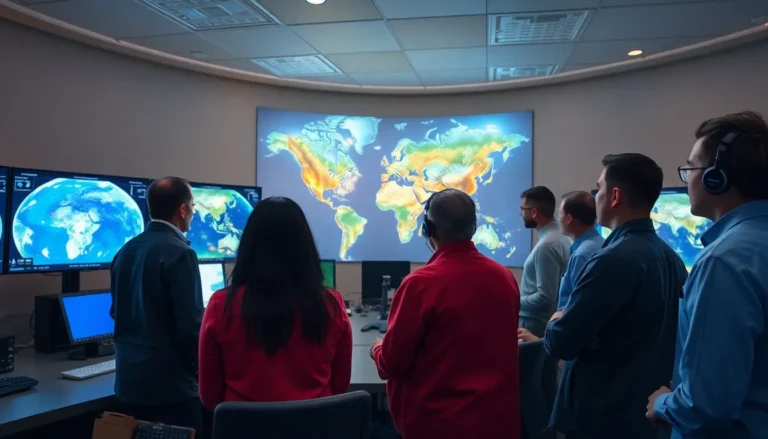Table of Contents
ToggleNurse education today is like a rollercoaster ride—thrilling, a little scary, but absolutely necessary. With the healthcare landscape evolving faster than a caffeine-fueled nurse during a night shift, aspiring nurses must adapt to new challenges and technologies. Gone are the days of just memorizing anatomy; today’s nursing students juggle clinical practice, online simulations, and the occasional existential crisis about whether they’ll ever master IV insertion.
But fear not! This isn’t just a tale of textbooks and lectures. It’s a vibrant world where passion meets innovation, creating a new generation of healthcare heroes. From cutting-edge training programs to hands-on experiences, nurse education is transforming to meet the demands of modern medicine. Join the journey as we explore the ins and outs of nursing education, where the stakes are high, but the rewards are even higher.
Overview of Nurse Education Today
Nurse education encompasses a diverse range of programs designed to prepare future nurses for the complexities of modern healthcare. Traditional paths, such as diploma and associate degree programs, exist alongside bachelor’s, master’s, and doctoral degrees, offering various entry points into the nursing profession. As healthcare evolves, the curriculum integrates sophisticated technologies and practices, ensuring nurses are equipped for real-world challenges.
Licensure requirements emphasize both clinical skills and theoretical knowledge. Clinical practice remains a cornerstone, complemented by online simulations that facilitate learning in a risk-free environment. Emphasis on evidence-based practice empowers students to deliver safe and effective patient care.
In addition, mentorship plays a crucial role in student development. Experienced nurses provide guidance, fostering critical thinking and professional growth. Collaborations between nursing schools and healthcare organizations enhance practical training opportunities, ensuring students gain valuable hands-on experience.
Interprofessional education increasingly highlights the importance of teamwork. Collaborative learning with medical, pharmacy, and social work students prepares nurses for integrated care models. Such experiences contribute to improved communication and collaborative skills essential in today’s healthcare landscape.
Nursing education today not only adapts to emerging challenges but also inspires passion for the profession. The dedicated educators strive to instill a commitment to lifelong learning and professional excellence, equipping nurses not only for their initial roles but also for ongoing development in their careers. Aspiring nurses embark on their journeys, navigating the complexities of education while embracing the transformative nature of the profession.
Evolution of Nursing Education
Nursing education has undergone significant transformation over the years, adapting to changes in healthcare and society. This evolution reflects a commitment to improving patient care and outcomes.
Historical Context
Nursing education began with informal training, primarily learning from observation and apprenticeship. Programs evolved during the late 19th and early 20th centuries with the establishment of formal nursing schools. The Nightingale Pledge, formulated in 1893, emphasized ethics and patient care, shaping future curricula. The introduction of the associate degree in nursing during the 1950s expanded access to nursing education, allowing more individuals to enter the field quickly. By the 1980s, the focus shifted towards bachelor’s and higher degree programs, emphasizing advanced clinical knowledge and skills.
Modern Developments
Current nursing education incorporates technology extensively. Online simulations and virtual reality enhance clinical skills training in a risk-free environment. Hybrid models of education blend traditional classroom materials with hands-on practice. Interprofessional education now plays a critical role, allowing nursing students to collaborate with peers from other healthcare disciplines. Programs also prioritize mentorship, pairing students with experienced professionals for guidance. Continuous advancements ensure that nursing curricula remain relevant and capable of meeting modern healthcare demand.
Current Trends in Nurse Education
Nurse education continuously evolves to meet the demands of modern healthcare. Current trends focus on innovative delivery methods and unique training experiences.
Online Learning Opportunities
Online learning opportunities offer flexibility and accessibility for nursing students. Many institutions now provide fully online programs, allowing students to balance education with personal responsibilities. Asynchronous courses enable learners to study at their own pace while maintaining work-life balance. Additionally, blended programs combine in-person clinical experiences with online coursework. This approach maximizes convenience while ensuring clinical competencies are achieved.
Simulation-Based Training
Simulation-based training serves as a cornerstone of today’s nursing education. High-fidelity simulators replicate real-life healthcare situations, offering a safe environment for skill development. These simulations enhance critical thinking and decision-making abilities. Real-time feedback during simulations allows students to refine their techniques and enhance patient care skills. Educators integrate technology effectively, ensuring that students experience a variety of clinical scenarios without risk to actual patients.
Challenges Facing Nurse Education Today
Challenges in nurse education surface from various sources, impacting both educators and students. Faculty shortages emerge as a significant concern, threatening the quality of education. Many institutions report difficulties in hiring qualified nursing faculty due to competitive job markets and retirement rates. A decrease in faculty leads to larger class sizes, preventing students from receiving individualized attention. Strikingly, a shortage of faculty members raises concerns about meeting accreditation standards and maintaining educational quality.
Student diversity presents both opportunities and challenges within nursing programs. Aspiring nurses represent various backgrounds, life experiences, and learning styles. Incorporating diverse perspectives fosters a richer educational environment. However, differences in academic preparedness often create barriers, requiring tailored support strategies to ensure success. Institutions must prioritize inclusivity in curricula and teaching methods while addressing the unique needs of diverse student populations. Recognizing these challenges can help create equitable learning environments essential for developing skilled nursing professionals.
Future Directions for Nurse Education
Nurse education continuously evolves to meet healthcare demands. Future directions will focus on innovation and adaptability.
Curriculum Innovations
Curriculum innovations emphasize competency-based learning. Programs now integrate experiential learning with traditional lectures. Active learning strategies promote critical thinking and enhance problem-solving skills. Simulations and case studies allow students to apply their knowledge in realistic scenarios. Partnerships with healthcare organizations help ensure curricula stay relevant to industry needs. Incorporating feedback from practicing nurses shapes curricula that reflect contemporary practices. Global health perspectives are increasingly included, preparing students for diverse patient populations.
Technological Integration
Technological integration plays a vital role in shaping nurse education. Online learning platforms offer flexible access to coursework for various student needs. Enhanced electronic health record systems facilitate training in critical documentation skills. Advanced simulations with high-fidelity mannequins replicate real-life situations, boosting students’ clinical reasoning. Social media and collaboration tools encourage peer-to-peer learning and networking. Data analytics technology supports personalized learning paths, allowing students to progress at their own pace. Virtual reality is emerging as a resource for immersive training experiences, expanding learning opportunities beyond the classroom.
Nurse education today stands at the intersection of tradition and innovation. As the healthcare landscape evolves rapidly, so do the methods and practices in nursing education. The integration of technology and simulation-based training equips aspiring nurses with the skills necessary to thrive in real-world settings.
With a focus on mentorship and collaboration, nursing programs are fostering a supportive environment for students. This nurturing atmosphere not only enhances learning but also prepares future nurses to tackle the complexities of patient care.
The commitment to inclusivity and adaptability ensures that nursing education remains relevant and effective. As challenges arise, the dedication to continuous improvement in nurse education promises a bright future for both students and the healthcare profession.




